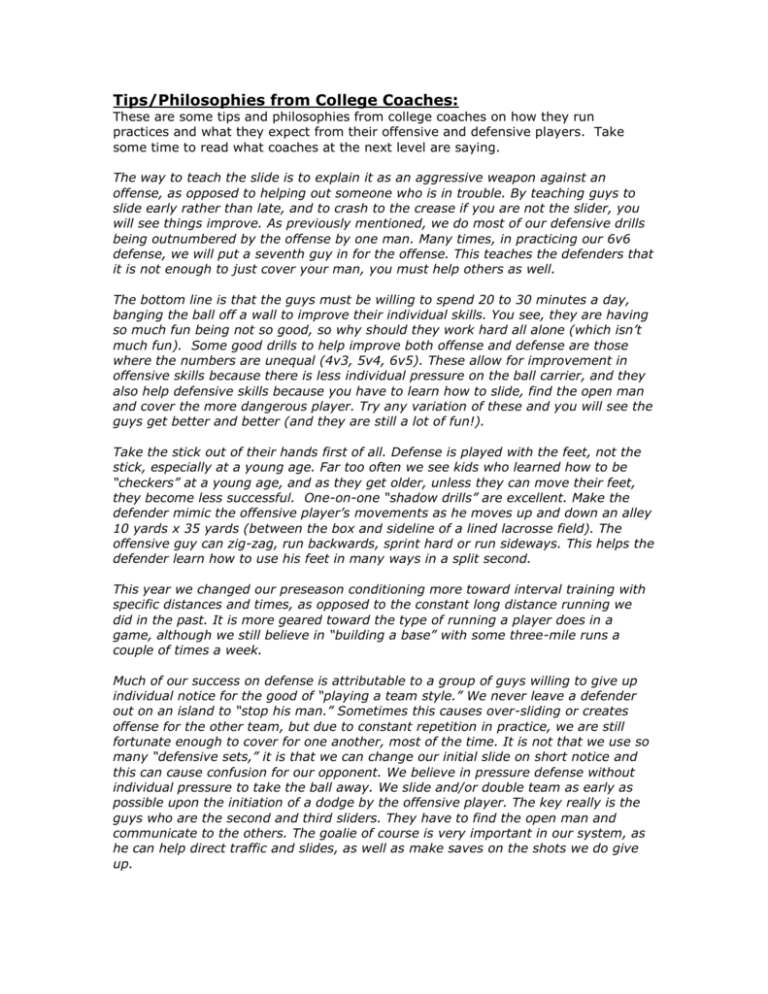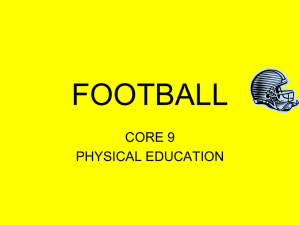The way to teach the slide is to explain it as an aggressive weapon
advertisement

Tips/Philosophies from College Coaches: These are some tips and philosophies from college coaches on how they run practices and what they expect from their offensive and defensive players. Take some time to read what coaches at the next level are saying. The way to teach the slide is to explain it as an aggressive weapon against an offense, as opposed to helping out someone who is in trouble. By teaching guys to slide early rather than late, and to crash to the crease if you are not the slider, you will see things improve. As previously mentioned, we do most of our defensive drills being outnumbered by the offense by one man. Many times, in practicing our 6v6 defense, we will put a seventh guy in for the offense. This teaches the defenders that it is not enough to just cover your man, you must help others as well. The bottom line is that the guys must be willing to spend 20 to 30 minutes a day, banging the ball off a wall to improve their individual skills. You see, they are having so much fun being not so good, so why should they work hard all alone (which isn’t much fun). Some good drills to help improve both offense and defense are those where the numbers are unequal (4v3, 5v4, 6v5). These allow for improvement in offensive skills because there is less individual pressure on the ball carrier, and they also help defensive skills because you have to learn how to slide, find the open man and cover the more dangerous player. Try any variation of these and you will see the guys get better and better (and they are still a lot of fun!). Take the stick out of their hands first of all. Defense is played with the feet, not the stick, especially at a young age. Far too often we see kids who learned how to be “checkers” at a young age, and as they get older, unless they can move their feet, they become less successful. One-on-one “shadow drills” are excellent. Make the defender mimic the offensive player’s movements as he moves up and down an alley 10 yards x 35 yards (between the box and sideline of a lined lacrosse field). The offensive guy can zig-zag, run backwards, sprint hard or run sideways. This helps the defender learn how to use his feet in many ways in a split second. This year we changed our preseason conditioning more toward interval training with specific distances and times, as opposed to the constant long distance running we did in the past. It is more geared toward the type of running a player does in a game, although we still believe in “building a base” with some three-mile runs a couple of times a week. Much of our success on defense is attributable to a group of guys willing to give up individual notice for the good of “playing a team style.” We never leave a defender out on an island to “stop his man.” Sometimes this causes over-sliding or creates offense for the other team, but due to constant repetition in practice, we are still fortunate enough to cover for one another, most of the time. It is not that we use so many “defensive sets,” it is that we can change our initial slide on short notice and this can cause confusion for our opponent. We believe in pressure defense without individual pressure to take the ball away. We slide and/or double team as early as possible upon the initiation of a dodge by the offensive player. The key really is the guys who are the second and third sliders. They have to find the open man and communicate to the others. The goalie of course is very important in our system, as he can help direct traffic and slides, as well as make saves on the shots we do give up. In terms of what I think the most reliable check is, well, my opinion on this as a coach is much different than it was as a player. I now believe that the less risk a defender takes, the better off he and his team will be. If I had to choose one, I would say it would be a short, quick slap check. What I have found is, because of the design of all these new sticks, it is more difficult than ever to dislodge the ball with one or two simple checks. Most players, unless very talented, are better off not checking. The most difficult move for me to defend was when an offensive player changed direction multiple times or dodged in and out. As a player that liked to check, it is tough to get a beat on on offensive player that is changing direction thus making it more difficult for me to time my checks. Also, defending players that ran right at me and got into my hands was tough because these types of players took away my ability to check. There is no short cut to achieving success. In other words, be patient with yourself. Developing your stickwork, especially your weaker hand takes time and a lot of practice. It sounds like you are already off to a good start. Keep carrying your stick around with you. Also, you may want to think about developing a 20 - 30 minute wall workout where you throw the ball up against a wall with your weak and strong hands. You can start with both hands on your stick and progress to using just one. Stand about 5 feet from the wall and slowly move backwards as you begin to feel more comfortable. Repetition is the key here. If you can catch and throw with both your strong and weak hands every day for 20 - 30 minutes you will be surprised with the results. I believe that my intensity comes from my passion for the sport of lacrosse, my strong desire to win and my wish for our players to become champions. I believe that if you are going to do something the right way, you need to put your heart and soul into it. For me, this means bringing an intense approach to most things I do. It's always difficult to play against someone that has superior athleticism. Despite this advantage, I believe you can still successfully cover these types of players. When facing a superior player it is important to use your head. If the player you are defending has greater speed than you, it might be a good idea to lay off him a little more than usual. This extra space would help you to counter the difference in speed. I certainly wouldn't go out and force the hand of a player that has better speed. Something else you and your team could try would be to slide to this player very early. Don't allow him to beat you. By sliding to him early you may cause him to pass the ball. This will force the other players on his team to make plays. When a defense slides and recovers it is basically encouraging the offense to try and beat them with ball movement. The slide and recover style of defense slides to stop a dodge and sends the player that was defending the ball to the inside and then onto the furthest man from the ball. This type of defense anticipates being able to recover (Check up) before the offense can find the open man(RED). The slide and double defense is a more aggressive style. In this scheme the defense will slide to not only stop the dodger, but to also double him. Both the slider and original defender will stay on the ballcarrier until he loses the ball, passes it or shoots. In order to successfully utilize this type of scheme the defensive team must shut off the adjacent pass once a slide has been executed. This will prevent an easy outlet. A team may employ this type of defense if the offensive team is dodging the slider, or if they are having difficulty recovering quickly enough. It can also be used if the dodger is a little selfish or if he dodges with the intention to only score, not pass. This is a great defense for a team that holds an athletic advantage to use. It will put a great deal of pressure on the offensive team.(WHITE) A lot of young defenders make the mistake of assuming that if they don't take the ball away then they haven't done a good job or they won't be considered a good player. This couldn't be further from the truth. In order to be a good take-away guy, you must first be a position player. Checks don't work if you are out of position. The bottom line is that defensemen DO NOT have to take the ball away to be good or great! It took me a long time to realize this. The key to having your team ready is for them to believe in themselves. This happens through hard work and dedication in practice. If a team can consistently walk off the practice field knowing it has made improvement, then the confidence will grow. Perhaps the two most important elements to success are sacrifice and discipline. The best teams I have coached had both traits. The players were unselfish and wanted to win for their teammates first. They were also willing to do whatever it took for the team to be successful. The discipline came in the decisions they made on and off the field. Distractions can kill a season. We have a 20-minute shooting period each practice. Coach Triolo works with the attack and Coach Kip Lukralle works with the midfielders on proper shooting techniques. Each group starts with 100 balls each. At the end of our session they have shot the ball at least 30-50 times each.






